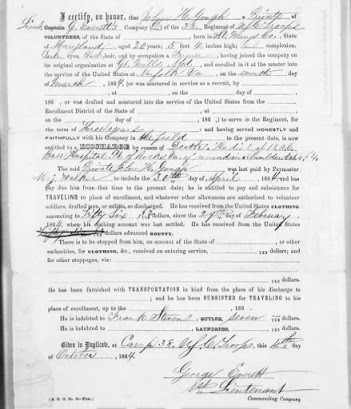The Chesapeake Bay area proved to be a particularly fruitful recruiting ground for the United States Colored Troops. Generations of tobacco agriculture had significantly depleted the region’s soil, and a transition to grain crops in the antebellum years produced a perceived surplus of enslaved laborers. Many of these individuals ended up being either sold, or moved with their migrating owners, to the ever expanding “Cotton Kingdom.” However, the region still had a large African American population, both free and enslaved. When the Civil War began, Federal control of the bay area resulted in tens of thousands of black men, women, and children assisting the Union war effort in multiple ways, which they obviously viewed to their advantage.
Thousands of the region’s military age men enlisted in United States Colored Troops regiments, like the 4th, 7th, 9th, 19th, 30th, 36th, and 38th who were either raised from or stationed in the area. Medal of Honor recipients Christian Fleetwood (4th), William H. Barnes (38th), James H. Harris (38th), and Decatur Dorsey (30th) all came from the bay section of Maryland. Barnes and Harris both hailed from St. Mary’s County, Maryland.
Six men in the 38th USCI with the last name of Gough (apparently pronounced Goff) are also among the men from St. Mary’s County. Two of the six died from the wounds received at the Battle of New Market Heights. The family relationship between Thomas A. Gough and John Henry Gough (if one existed) is unknown. It is quite possible they were either brothers or cousins. Although they were in the same regiment, and hailed from the same county, they enlisted three months apart and ended up in different companies. However, they are of similar age, were the same height, and same complexion. We’ll look at each soldier individually.

John Henry Gough was only 20 years old when he enlisted on February 27, 1864, in Great Mills, Maryland. John’s enlistment papers describe him as 5 feet, 4 inches tall, and of “dark” complexion. Noted as “farmer,” before enlisting, he was likely enslaved before joining up. John had probably not traveled far in his first 20 years, as he gave his birthplace as St. Mary’s County. He officially mustered into the U.S. service on March 7, in Norfolk, Virginia.

John’s time in the blue uniform would span just a little over seven months. His records reveal no illness, no absences, no detached duty. He did not received any promotions. It appears that he always answered roll calls with, “present.” However, during the intense fighting at the Battle of New Market Heights on September 29, 1864, John Henry received a serious wound in one of his shoulders. Removed from the battlefield and taken to the XVIII Corps base hospital at Point of Rock, Virginia, John died from his wound on October 4. His soldier’s Final Statement lists no personal effects.

Pvt. Thomas A. Gough enlisted at age 22 into Company F of the 38th USCI on May 17, 1864 at Leonardtown, Maryland. His physical description mirrors that of John Henry Gough exactly. He officially mustered in on May 22 in Norfolk. In service for even less time than John Henry, the comments on Thomas’ muster card for September-October 1864 reads: “Died of wounds rece’d in a charge on the enemy’s works Sept 29, 1864.”

Pvt. Thomas Gough’s discharge for death document provides some insight into the wounds he received in the courageous charge at New Market Heights. Shot through the right lung and right arm, Thomas—like John Henry Gough—left the battlefield clinging to life, but obviously in tremendous pain. Transported to the XVIII Corps base hospital at Point of Rocks, he endured the amputation of his right arm. Thomas held on to his life until October 13.
Apparently both men received burials in the Point of Rocks hospital cemetery on Bermuda Hundred. Later removed, and now occupying graves only a row and a few short steps apart, they now rest in peace in plots 3707 and 3699 respectively in the City Point National Cemetery.
Only two decades of life makes for excruciatingly short existences for these two soldiers. The principles they fought for, and sacrificed their lives for, should ideally bring them a measure of recognition and the thanks of a nation. Their marked graves in a national cemetery helps. Bringing their courageous stories to a wider audience, and thus creating awareness of their service is one of the goals of the Battle of New Market Heights Memorial and Education Association. Help us remember them.

